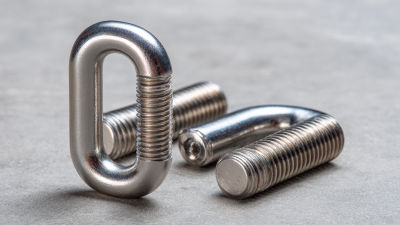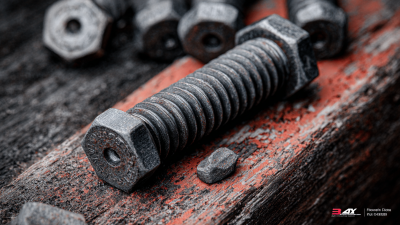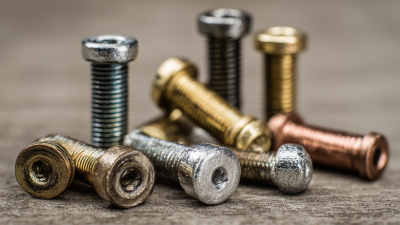In the realm of industrial applications, the significance of Stainless Steel U Bolts cannot be overstated, particularly when considering their longevity and load capacity. According to a report by Global Market Insights, the demand for stainless steel fasteners, including U Bolts, is projected to reach a value of $20 billion by 2026, driven by their superior corrosion resistance and strength. These properties make Stainless Steel U Bolts ideal for use in harsh environments, such as marine and chemical industries, where traditional materials often fail. Furthermore, the American Society for Testing and Materials (ASTM) outlines that properly designed U Bolts can withstand considerable loads, with tensile strengths exceeding 70 ksi. This combination of durability and reliability underscores the pivotal role Stainless Steel U Bolts play in ensuring the structural integrity and performance of various industrial systems. As industries evolve and challenges grow, the reliance on these fasteners will only increase, highlighting their importance in modern engineering solutions.

In industrial applications, the material selection for stainless steel U bolts is critical for ensuring both longevity and load capacity. Stainless steel, particularly grades like AISI 304 and AISI 316, is favored for its superior corrosion resistance and mechanical properties. According to a report by the American Institute of Steel Construction, the tensile strength of AISI 316 can reach up to 90,000 psi, making it ideal for high-stress environments where rust and degradation are concerns. This is especially true in marine and chemical processing industries, where exposure to harsh elements is prevalent.
Moreover, the impact of material selection extends beyond mere strength; it significantly influences the long-term performance and reliability of U bolts. A study published in the Journal of Manufacturing Processes highlighted that U bolts made from high-quality stainless steel can increase service life by up to 200% compared to lower-grade materials. This enhanced lifespan not only results in reduced maintenance costs but also optimizes system efficiency, making the choice of material a vital consideration for engineers and procurement professionals in various industrial sectors.
Stainless steel U bolts are a fundamental component in many industrial applications, particularly due to their durability and load-bearing capabilities. When analyzing load capacity ratings for different grades of stainless steel U bolts, it’s essential to consider the tensile strength offered by each grade. For instance, Grade 304 stainless steel has a minimum tensile strength of 70,000 psi, which makes it suitable for a wide range of applications, while Grade 316 offers enhanced corrosion resistance and a slightly higher tensile strength, making it ideal for marine environments. These specifications are crucial for engineers when selecting appropriate U bolts for specific operational conditions.
Furthermore, industry studies indicate that U bolts subjected to dynamic loads can experience fatigue over time. Data from recent materials science research emphasizes that the load capacity of U bolts not only depends on the material grade but also on the design and manufacturing processes. For example, improper installation or inadequate torque can significantly reduce their effective load capacity, leading to potential structural failures. Thus, understanding the nuanced differences in load ratings and the operating conditions is vital for achieving optimal performance and safety in industrial applications.
| Grade | Material Type | Yield Strength (MPa) | Ultimate Tensile Strength (MPa) | Load Capacity (kg) | Corrosion Resistance | Typical Applications |
|---|---|---|---|---|---|---|
| 304 | Austenitic | 215 | 505 | 2040 | Good | Food Processing, Chemical Industry |
| 316 | Austenitic | 235 | 570 | 1830 | Excellent | Marine, Pharmaceutical |
| 410 | Martensitic | 310 | 550 | 1500 | Moderate | Automotive, Structural |
| 2205 | Duplex | 450 | 620 | 2700 | Very Good | Oil & Gas, Chemical Processing |
Stainless steel U bolts are widely used in various industrial applications due to their strength and versatility. However, their longevity is heavily influenced by factors such as corrosion resistance and environmental considerations. Stainless steel alloys, particularly those containing elements like nickel and molybdenum, provide enhanced resistance to corrosion, which is critical in environments exposed to moisture, chemicals, and fluctuating temperatures. This resilience helps maintain structural integrity over time, reducing the need for frequent replacements.
In addition to material selection, the environment in which U bolts are used plays a significant role in their lifespan. Exposure to harsh chemicals, saltwater, or extreme temperatures can accelerate corrosion and degradation. Protective coatings and proper installation techniques can further mitigate these risks. Additionally, regular maintenance and inspections are essential to identify potential issues early, ensuring that the U bolts continue to perform effectively under load without compromising safety and reliability. Understanding these factors is crucial for selecting the right U bolts for specific industrial applications, ultimately influencing their overall lifespan and load capacity.

When it comes to maximizing the performance of stainless steel U bolts in industrial applications, proper installation techniques play a pivotal role. According to a report by the American Society of Mechanical Engineers (ASME), approximately 30% of mechanical failures can be attributed to improper installation practices. Therefore, ensuring that U bolts are correctly positioned and tightened can significantly enhance their load capacity and longevity.
One of the critical aspects of installation is the application of the correct torque specifications. A study conducted by the National Association of Corrosion Engineers (NACE) indicates that using the appropriate torque can optimize the sealing capability and alignment of U bolts, reducing the risk of fatigue and failure. Furthermore, utilizing a consistent pattern while tightening bolts helps in distributing the load evenly, thereby improving the overall structural integrity of the assembly. Additionally, regular inspection and maintenance are essential, as highlighted in a recent report from the Institute of Corrosion Engineering, which found that periodic checks can prevent up to 60% of downtime related to fastener issues. Adopting these techniques ensures that stainless steel U bolts perform reliably under varying load conditions in industrial environments.
To ensure the longevity of stainless steel U bolts in harsh industrial conditions, implementing proactive maintenance practices is crucial. Regular inspection is the first step; U bolts should be checked for signs of corrosion, fatigue, or wear. Stainless steel, while resistant to rust, can still suffer from pitting and crevice corrosion, especially in environments where moisture and chemical exposure are prevalent. Cleaning the bolts and surrounding area can help mitigate these risks, as it removes debris and contaminants that can trap moisture.
Additionally, applying protective coatings can significantly enhance the durability of U bolts. These coatings act as barriers against corrosive elements, thus extending operational life. Furthermore, ensuring that the bolts are correctly torqued during installation prevents undue stress that can lead to failure. Periodic retightening after initial use is also advisable, as thermal expansion and vibration can loosen bolts over time. By adopting these maintenance practices, industries can improve the performance and reliability of stainless steel U bolts, ensuring they withstand demanding conditions effectively.







